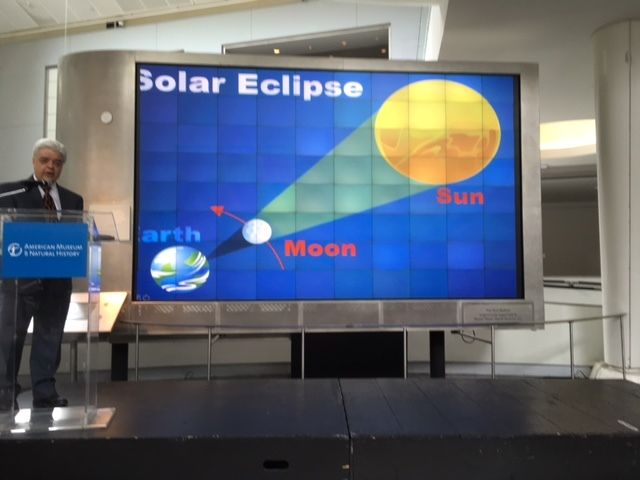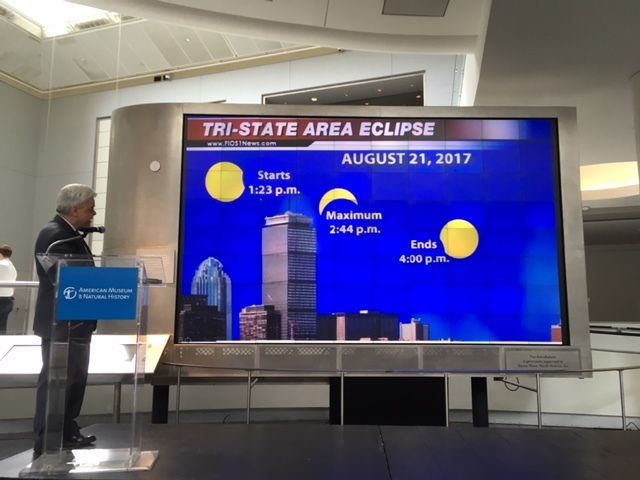
Joe Rao, Hayden Planetarium associate explains the line up of the Earth , moon and sun that makes a total eclipse posible
On Monday, August 21st, the shadow of the moon will totally block the sun from Oregon to Georgia over a period of 90 minutes. Such a total eclipse happens somewhere on earth every 18 months or so. But some places seem to get them more often than others. The last total solar eclipse for the New York City area took place on January 24, 1925. This time we will experience a partial of about 70%. The path of totality has a website and we will have to wait until 2079 for the next one. But amazingly— no matter where you live in the lower-48 you can see at least a part of this phenomenon.
On August 14, I went to a program at the American Museum of Natural History (AMNH) to get up-to-speed on the event from America’s most popular astrophysicist, Neil de Grasse Tyson, the Frederic P. Rose Director of the Hayden Planetarium and Planetarium astronomer, Jackie Faherty and Planetarium associate Joe Rao. All three were beyond enthusiastic for the event and the audience was polled—How many of you have seen a total eclipse of the sun? There were quite a few who raised their hands but weren’t certain. Joe Rao said, “The only people who really saw it would respond, OMG!” The rest of us had witnessed a partial, which Jackie Faherty said is “nothing to turn up your nose at.” Of course, the three panelists had long ago made plans to seek totality. Wherever they are it its path, totality will last at most a little more than two minutes.

This is what we’ll see in the tri-state area.
The reason a total eclipse can happen at all, as Jackie Flaherty explained, is because of the amazing coincidence that the moon is about 400 times closer to the earth than the sun and the sun is 400 times larger than the moon. So, when they line up correctly, the moon and sun appear to be about the same size, which is why the moon can completely block the sun castin a circular shadow that is it 70 miles wide on the Earth. The path of the partial eclipse is much wider—most of the American population will see something, if they look carefully. This means looking through welder’s glass #13 or #14 or getting the paper glasses that are ubiquitous until you try and find some or make pinhole in an index card, turn your back to the sun so the sun’s rays land on the pinhole, which acts like a lens and focuses the image on a piece of paper held below the pinhole. Dr. Tyson suggest holding a colander up to the sun and see many small images of the event on a smooth surface on the ground. It is going to happen quickly. The shadow is traveling at 1000 miles per hour, so you’ve got only a few minutes to be in it.
But it is the experience of totality that calls to these scientists. Jackie Flaherty said: “ I’ve thought about this a lot. It’s been on my bucket list. As it’s happening, you get the opportunity to stand in the shadow of the moon. Now the last time we went to the moon was decades ago. I can say with some definitiveness that I don’t think I’ll ever have the opportunity to go to the moon……... But I see the moon on so many nights and I feel a connection to it…..I want to stand in the darkest part of the moon’s shadow. It is the closest connection that I’m ever going to have to that object that’s so important to the night time sky, to the astronomer that I am, and it’s not just that…. but this idea we have a sun that is source of where this planet came from and as a human being it is so important and we predicted that moment and you watch it goes away. As a human being that relies on that thing [the sun] that gave us life, it seem like an an enormous moment to watch that thing disappear and to watch it come back. It’s a wonderful affirmation of how astronomers are doing their job; we predicted when it would happen and we gave you the time it was going to happen and where it was it going to happen. I want to be there when it happens.”
Joe Rao said, “Maybe you can ‘t touch the moon but it is the one and only chance that its shadow will touch you. That shadow will come racing toward you at a speed of 1000 miles per hour and will last for only a few precious moments and you will see something really different.”
All three panelists will be somewhere in totality but Neal de Grasse Tyson’s location is a secret. He will leave the commentary on the eclipse up to others.
Apparently, many intend to travel to totality and for those of us in the partial areas, there doesn’t seem to be a pair of eclipse glasses to be found. They have sold out. If you want to see eclipse safely without glasses look at the images that pass through the holes of a colander and watch how sharp the shadows of the leaves become.
